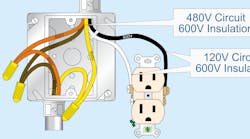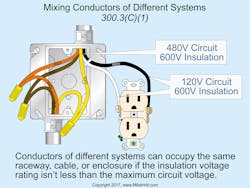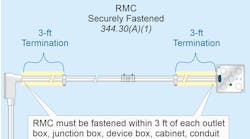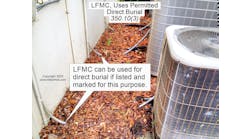All questions and answers are based on the 2017 NEC.
Underlined text indicates a Code change.
Q. What is the NEC requirement on grouping circuit conductors together?
A. Conductors of the same circuit and, where used, the neutral and equipment grounding and bonding conductors must be installed in the same raceway, cable, trench, cord, or cable tray, except as permitted by Sec. 300.3(B)(1) through (4).
(1) Paralleled installations. Conductors installed in parallel in accordance with Sec. 310.10(H) must have all circuit conductors within the same raceway, cable tray, trench, or cable. Note: To minimize induction heating of ferrous metal raceways and ferrous metal enclosures for alternating-current circuits, and to maintain an effective ground-fault current path, all conductors of a circuit must be installed in the same raceway, cable, trench, cord, or cable tray. See Secs. 250.102(E), 300.3(B), 300.5(I), 300.20(A), and 392.8(D).
Exception: Parallel phase and neutral conductors can be installed in individual underground nonmetallic raceways (Phase A in raceway 1, Phase B in raceway 2, and so forth) as permitted by Sec. 300.5(I) Exception No. 2, if the installation complies with Sec. 300.20(B).
(2) Outside a raceway or an enclosure. Equipment grounding jumpers can be located outside of a flexible raceway if the bonding jumper is installed in accordance with Sec. 250.102(E)(2). For DC circuits, the equipment grounding conductor can be run separately from the circuit conductors in accordance with Sec. 250.134(B), Exception No. 2.
(3) Nonferrous wiring methods. Circuit conductors can be installed in different raceways (Phase A in raceway 1, Phase B in raceway 2, and so on) if, in order to reduce or eliminate inductive heating, the raceway is nonmetallic or nonmagnetic and the installation complies with Sec. 300.20(B). See Sec. 300.3(B)(1) and Sec. 300.5(I), Exception No. 2.
Rules for working with conductors of different systems [Sec. 300.3(C)]:
(1) Mixing. Power conductors of AC and DC systems rated 1,000V or less can occupy the same raceway, cable, or enclosure if all conductors have an insulation voltage rating not less than the maximum circuit voltage (Figure).
Informational Note 1: See Sec. 725.136(A) for Class 2 and Class 3 circuit conductors.
Control, signal, and communications wiring must be separated from power and lighting circuits so that the higher‑voltage conductors don’t accidentally energize the control, signal, or communications wiring:
• Class 1 control circuits [Sec. 725.48]
• Class 2 and Class 3 control circuits [Sec. 725.136(A)]
• Communications circuits [Sec. 800.133(A)(1)(c)]
• Coaxial cable [Sec. 820.133(A)]
• Fire alarm circuits [Sec. 760.136(A)]
• Sound circuits [Sec. 640.9(C)]
Class 1 circuit conductors can be installed with associated power conductors [Sec. 725.48(B)(1)] if all conductors have an insulation voltage rating not less than the maximum circuit voltage [Sec. 300.3(C)(1)].
A Class 2 circuit that’s been reclassified as a Class 1 circuit [Sec. 725.130(A), Exception No. 2] can be installed with associated power conductors [Sec. 725.48(B)(1)] if all conductors have an insulation voltage rating not less than the maximum circuit voltage [Sec. 300.3(C)(1)].
Holt is the owner of Mike Holt Enterprises, Inc. in Leesburg, Fla. He can be reached at www.mikeholt.com.





